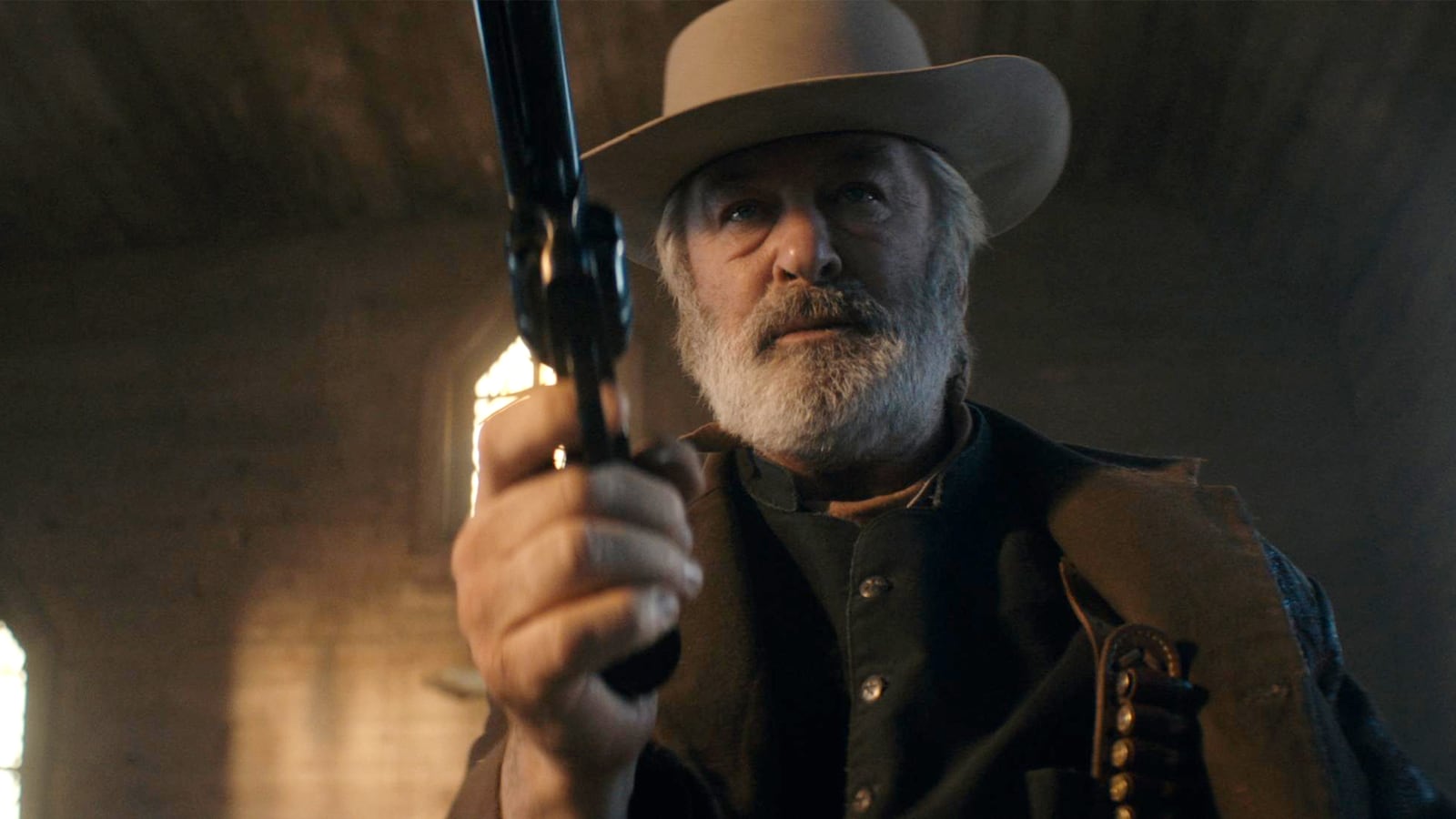Rust will forever be defined by the tragic 2021 accidental death of its cinematographer Halyna Hutchins, and questions about the prudence of completing the feature are only exacerbated by the finished product.
Writer/director Joel Souza’s run-of-the-mill Western is far less gripping than the real-life drama that played out on the nightly news regarding star/producer Alec Baldwin’s alleged responsibility for the fatal mishap—charges which were ultimately dropped and dismissed. Rehashing clichés with formal polish but little novelty, this oater is a dour affair made all the grimmer by the fact that there isn’t a second of its 139 minutes that isn’t colored, in some way, by the on-set shooting that made it notable, and notorious, in the first place.
It’s impossible to watch Rust, which is in theaters and on VOD May 2, and avoid thinking about Hutchins’ unnecessary demise (for which armorer Hannah Gutierrez-Reed was convicted), and not helping matters is that its action repeatedly, if unintentionally, evokes it.
Whether it’s talk about a cursed firearm that begets misfortune and misery, or Baldwin’s protagonist musing, “Some things in this life you can’t get back, I reckon,” echoes abound. And that’s without even mentioning the multiple times that someone points a gun in the general direction of the camera—the very sort of composition that led to Hutchins and Souza being shot (her fatally) during the film’s initial phase of production. With more than one character (including Baldwin’s) expressing remorse and guilt over irreversible calamities in which they had a hand, it winds up resonating in the worst way imaginable.
There’s no escaping reminders of Hutchins throughout Rust, and that’s also because the film’s most impressive aspect is its cinematography.

Though its visuals tend to get a tad redundant once it crosses the midway point, the late artist provides a bevy of striking Old West sights, most of them involving horseback riders traversing dusty plains, scraggly hilltops, bubbling creeks, and sandy gulleys at sunset, with the sparkling sun peeking through enormous clouds in a manner that casts everyone in iconic silhouette.
These images are so common that they eventually lose some of their luster. Nonetheless, they’re uniformly well-crafted and arresting, as are daytime sequences that have a slightly burnished, metallic sheen that’s in keeping with the material’s severity.
It’s more than a bit heartbreaking that Rust‘s most noteworthy element is its aesthetics, which were seamlessly finished by Bianca Cline. Yet setting aside its behind-the-scenes disaster—an impossible task, of course—the film remains a competent, formulaic gunslinger saga about parents and children, sin and salvation, faith and despair.
In 1882 Wyoming, 13-year-old Lucas (Patrick Scott McDermott) cares for his doting younger brother Jacob (Easton Malcolm) on a farmstead that he’s inherited from deceased parents. This is an onerous burden for a teenager, and Lucas handles it without complaint, going about his daily chores with dutiful proficiency. On a trip into town, however, his life goes off the rails when he viciously defends Jacob from a bully, thereby earning the ire of the injured boy’s father, who promises to make Lucas handle the toil that his son can no longer perform. When the man comes calling to collect on this debt, Lucas shoots him dead and is consequently tried and convicted of murder, and sentenced to hang.
Before that fatal day can arrive, Lucas is busted out of prison by a mysterious stranger whom he learns is Harland Rust (Baldwin), an infamous bandit who’s wanted for a string of bank robberies and murders. Rust is thus more successful at extricating the boy from incarceration than was his great aunt Evelyn (Frances Fisher), and it’s not long before Lucas is informed that the desperado is his grandfather.
Rust is far from a friendly guy, prone to ordering the kid around and screaming at him when he doesn’t comply or whines about wanting things to go back to the way they were. If you think they’re fated to slowly warm to each other—with Lucas coming to understand that Rust had justifiable reasons for going outlaw, doesn’t like to kill, and regrets abandoning his daughter—then you’ve seen any number of prior Westerns that hew to a similar narrative template.
Making Rust more conventional, Rust and Lucas are tracked by a U.S. Marshall named Wood Helm (Josh Hopkins) who desires justice, and a bounty hunter who goes by Preacher (Travis Fimmel) and covets the $1,000 reward for their capture.
Wracked by the impending death of his sickly son, whom his wife chides him for ignoring, Wood has lost his faith in God. Preacher, on the other hand, is a true believer with a malevolent streak, acting pious and violent in equal measure with the prostitute and widow he beds.

Still, regardless of this peripheral focus on religion, Souza tells a straightforward tale whose main interest is Rust’s redemption. To earn that, he must narrow the chasm between himself and Lucas and protect the boy whenever trouble arises. With the exception of one late skirmish, in which Rust and Lucas appear, preposterously, to flee a deadly gunfight by oh-so-slowly retreating, those clashes are handled with aplomb, full of suspenseful build-ups and brutal payoffs.
While Rust is a functional rehash, Baldwin is never wholly convincing as a grizzled 19th-century ne’er-do-well with a heart of gold; there’s something about his hardness that doesn’t quite gibe with the Wild West setting. To some extent, such inauthenticity is emblematic of most of Rust, which is akin to a cover song that hits all the proper notes but fails to capture its predecessors’ rugged soul.
Souza’s script is overtaxed by hackneyed characterizations and plotting (not to mention a handful of unnecessary scenes that could have been easily excised), Fimmel’s villainous turn is rather plain (he’s even decked out in all black), and Hopkins’ noble lawman is a bore—deficiencies that escalate as the film moseys its way toward an inevitable conclusion.
Rust is most moving simply because, in its grand vistas and tender campfire and candlelit moments, it suggests that Hutchins had a bright cinematic future. It’s a shame, then, that her final work was on a ho-hum genre throwaway that’s beneath her considerable talents.









